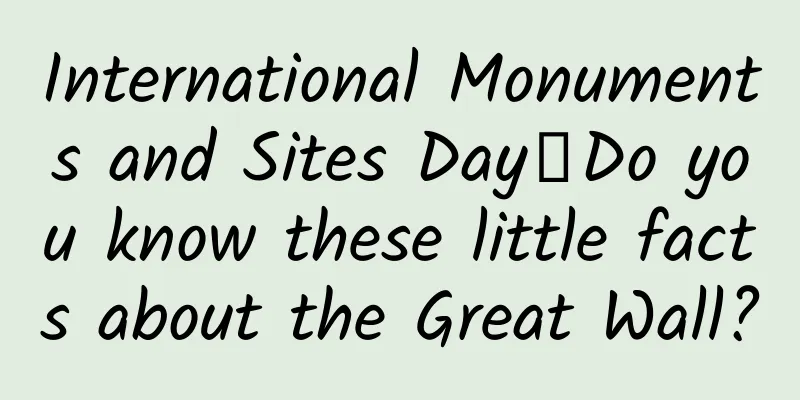International Monuments and Sites Day丨Do you know these little facts about the Great Wall?

|
Ancient monuments are important witnesses of the development of human history The protection of ancient monuments and sites is connected The past and future of human civilization To inherit and develop the excellent culture of mankind Of far-reaching significance Today (April 18) It is International Monuments and Sites Day The Great Wall, a Chinese Treasure Inscribed on the World Heritage List in 1987 It is one of the top ten cultural heritages in the world. It's like a book When you read carefully Not only will you read about the Great Wall itself, Deep, magnificent, tenacious There are also history, geography, culture, architecture... The Great Wall embodies the wisdom of ancient Chinese people How much little knowledge is hidden? Let’s find out together How long is the Great Wall? The Great Wall, known as "the first military project in ancient China", is unprecedented in its length, danger and difficulty in construction. It runs across 15 provinces, municipalities and autonomous regions, including Hebei, Beijing, Tianjin, Shanxi, Shaanxi, Gansu, Inner Mongolia, Heilongjiang, Jilin, Liaoning, Shandong, Henan, Qinghai, Ningxia and Xinjiang. In 2012, the State Administration of Cultural Heritage announced that the total length of the Great Wall in China, based on a six-year survey, was 21,196.18 kilometers. Future surveys may increase this number. Figuratively speaking, if you were to build a straight wall between the South Pole and the North Pole, the length of the Great Wall would be a little longer than this wall. (Copyrighted image from the gallery, no permission to reprint) Where are the starting and ending points of the Ming Great Wall? The Great Wall was first built during the Zhou Dynasty, the Spring and Autumn Period and the Warring States Period. During the reign of Qin Shihuang, the Great Walls of Qin, Zhao, Yan and other states were connected to form the Great Wall. After that, large-scale construction was carried out during the Han Dynasty and the Ming Dynasty. At present, the Ming Great Wall is the best preserved Great Wall relic. In the 1980s, archaeologists discovered the ancient city wall and foundation ruins in front of and behind Hushan on the Yalu River on the Sino-North Korean border in Dandong City, Liaoning Province. After a long period of archaeological investigation, archaeologists and Great Wall scholars finally confirmed that this section of the Great Wall stretches for more than 1,000 kilometers in Liaodong and extends westward to Shanhaiguan, which is part of the Ming Dynasty Great Wall. Since then, it has become a consensus in the academic community that the Great Wall starts from Hushan in Liaoning in the east and ends at Jiayuguan in Gansu in the west. (Copyrighted image from the gallery, no permission to reprint) How many levels are there in the Great Wall? "I urge you to drink another cup of wine, for there will be no friends west of Yangguan." "Why should the Qiang flute blame the willows? The spring breeze does not reach Yumen Pass." How many levels are there in the Great Wall? There are thirteen passes in total on the Great Wall: Shanhaiguan, Huangyaguan, Juyongguan, Zijingguan, Daomaguan, Pingxingguan, Piantouguan, Yanmenguan, Niangziguan, Shahukouguan, Jiayuguan, Yangguan and Yumenguan. Have you counted them all? (Copyrighted image from the gallery, no permission to reprint) How does the Great Wall, which is exposed to wind and rain, drain water? The Great Wall has a very "intelligent" drainage system. Its main buildings are equipped with drainage facilities such as drainage ditches, water retaining bricks, and water spouts, which can drain the accumulated water in time and have withstood the test of continuous erosion and scouring by rainwater for thousands of years. The drainage ditch built on the top of the wall allows rainwater to be discharged outside the foundation of the wall through the water spouts on the inner eaves wall (Yu wall). At the intersection of the Great Wall and the river, there is often a double-hole round arched water gate, also known as a "water gate". There is a gatehouse on the water gate with a sluice gate inside to control the amount of water inside and outside the gate during the flood season and the dry season. The more famous water gates include Jiumenkou Great Wall, Badaling Water Gate Great Wall, Huangyaguan Great Wall Water Gate, etc. The Great Wall is a mark of civilization Condensed tenacity and faith Thousands of years of circulation Inside and outside the Great Wall at this time Exactly Green grass sways and mountain flowers bloom (Copyrighted image from the gallery, no permission to reprint) Further reading: What other historical sites are there? Is it worth counting them one by one? Qinling Terracotta Warriors The Qinling Terracotta Warriors and Horses are large in scale. The three pits cover a total area of more than 20,000 square meters. There are nearly 8,000 pottery figurines and horses, more than 100 wooden chariots and more than 40,000 bronze weapons in the pits. They show the Qin army's organization, weapons and equipment, and ancient war formations. In 1987, it was listed as a "World Cultural Heritage" by UNESCO. Beijing Summer Palace The predecessor of the Beijing Summer Palace was the Qingyi Garden. It is located in the western suburbs of Beijing and is one of the largest existing royal gardens in my country. It is a large-scale landscape garden built on the site of Kunming Lake and Wanshou Mountain, modeled on the West Lake in Hangzhou, and drawing on the design techniques of Jiangnan gardens. It is also the best-preserved royal palace and imperial garden, known as the "Royal Garden Museum". It was listed on the World Heritage List in 1998. The ruins of the ancient castle "Borbazhin" "Borbajin" was first discovered in 1891. It is located near Kungurtuk, a small town in the Tuva Republic in southern Russia. It covers an area of about 4 hectares and is dozens of kilometers away from the Russian-Mongolian border. Archaeologists have discovered relics of Chinese Tang Dynasty architectural features, including square building foundations, vertical beam structures, carved roof beam structures supporting the roof, ceramic tiles, and terracotta reliefs with carved patterns, auspicious patterns that are common in Chinese Tang Dynasty monuments. According to archaeological experts, the ancient city was not an ordinary wealthy family's residence, but might have been the palace of Princess Ningguo of the Tang Dynasty of China who married into the Uighurs. Portuguese Undersea Pyramids In 2013, fishermen discovered a huge pyramid on the seabed of the Azores in the Atlantic Ocean. It was 60 meters high and located about 1,500 kilometers west of the Portuguese capital Lisbon. Even the Portuguese Navy joined the exploration. It is speculated that this underwater pyramid may be the "lost empire" Atlantis Empire. Atlantis Empire, the name of an ancient continent, country or city-state with a highly developed civilization, was first described in the book "Dialogues" by the ancient Greek philosopher Plato. It is said that it was destroyed by a prehistoric flood around 10,000 BC. Stonehenge, England (Image copyright gallery, no permission to reprint) Stonehenge is a famous European prehistoric cultural temple site, located in Amesbury, a small village more than 120 kilometers away from London, England. It is also known as the "Salisbury Stone Circle", "Temple of the Sun", "Prehistoric Stone Table", etc. It covers an area of about 11 hectares and is mainly composed of many whole pieces of blue sandstone, each weighing about 50 tons. Its main axis, the ancient road leading to the stone pillar and the rising sun on the morning of the summer solstice are on the same line; in addition, the line connecting two of the stones points to the direction of the sunset on the winter solstice. In August 2013, archaeologists found at least 63 human remains in the excavation of the prehistoric Stonehenge, and speculated that it was originally a cemetery, and the construction of Stonehenge began about 100 years later. Recently, British experts have suggested that the site may be a suspended altar. Pyramids of Giza and Sphinx in Egypt (Image copyright gallery, no permission to reprint) The 10 pyramids in Giza, Egypt, are one of the Seven Wonders of the Ancient World and were selected as a UNESCO World Heritage Site in 1979. Among them, the Pyramid of Khufu is the largest of the three oldest pyramids in Egypt and the largest megalithic building in the world. The construction of the Great Pyramid of Khufu involved surveying, astronomy, mechanics, physics and mathematics. It is known as the greatest stone building in human history, and there are still many unsolved mysteries. The pyramid also complies with the "golden ratio", which is the best ratio in aesthetics. Easter Island, Chile (Image copyright gallery, no permission to reprint) Easter Island is an island in the South Pacific Ocean, called Rapa Nui in the local language, located 3,000 kilometers west of Chile. Easter Island is one of the most isolated islands in the world, and is more than 2,000 kilometers away from the nearest inhabited Pitcairn Islands. The island is roughly triangular in shape and consists of three volcanoes. It is one of Chile's two territories in the South Pacific along with the Juan Fernandez Islands. Easter Island is famous for its hundreds of mysterious giant stone statues. Machu Picchu in Peru (Image copyright gallery, no permission to reprint) Machu Picchu means "ancient mountain" in Quechua. It is also known as the "lost Inca city". It is a well-preserved pre-Columbian Inca ruins. Machu Picchu is the most important archaeological excavation center in South America and is therefore the most popular tourist attraction in Peru. Due to its unique location, geographical features and late discovery, Machu Picchu has become the most familiar symbol of the Inca Empire. In 1983, Machu Picchu was designated a World Heritage Site by UNESCO and is one of the few cultural and natural heritage sites in the world. Chichen Itza, Mexico (Image copyright gallery, no permission to reprint) Chichen Itza is an ancient Mayan city site located in the southern part of Yucatan, Mexico. It is 3 kilometers long from north to south and 2 kilometers wide from east to west. There are hundreds of buildings. It is a site of ancient Mayan culture and Toltec culture. "Chichen" means "wellhead", and the natural well is the foundation of the city. The existing road divides it into two halves. The old Chichen Itza on the south side was built between the seventh and tenth centuries AD and has Mayan cultural characteristics, including pyramid temples, pillar halls, ball courts, markets and astronomical observatories, and is mainly decorated with stone carvings. The new Chichen Itza on the north side is a grey building with Toltec cultural characteristics, including the Kukulkan Pyramid, the Temple of Warriors, etc., decorated with simple lines and plaster carvings of Quetzalcoatl. Protecting ancient sites is not only a respect for history, but also the best wealth left for ourselves. On the evening of April 15, 2019, a fire broke out in Notre Dame Cathedral in Paris, France, and the whole world was heartbroken. This Gothic building standing on the banks of the Seine was likened by Hugo to a "symphony of stone". It is an important symbol of French civilization and an outstanding treasure of human civilization. Monuments are witnesses of history It is also the inheritance of culture Protecting cultural relics and monuments Let’s take action together! Comprehensive sources: CCTV News Client, China Huaxia Cultural Heritage Foundation, etc. |
<<: Six flight missions have been confirmed for this year! And here are some breaking news →
>>: How painful is it to be overly sensitive in this part of the body?
Recommend
Charging piles have become a key factor in promoting electric vehicles. Can CNPC and Sinopec help build charging facilities?
At present, the country is vigorously promoting p...
How can we measure the speed of light when it is so fast?
The speed of light in a vacuum can be said to be ...
Analysis of competing products for 618 events on Tmall, JD.com and others!
This article will analyze the 618 activities of o...
iOS View---Exploration of Animation Rendering Mechanism
When developing a terminal, the first thing to co...
When HDR becomes the standard for future TVs, are we still far away from better display effects?
Although the entire technology industry has inves...
Lithium battery technology has made another contribution to the electric vehicle's range is expected to be extended by 2 times
On December 13, according to Futurism, as more an...
If you are not good at physics, please do not click on this article
Remember this fairy-like iced food in the restaur...
How to write a promotional plan and how to package it
1. What is a promotion plan? Before we know how t...
One-third of children do not get enough sleep. How much sleep do children need in a day?
Just as electronic devices need to be charged, sl...
Is it better to sleep with the window open or with the air conditioner on when it's hot? The doctor's answer is surprising
In the hot summer nights, the temperature is so h...
iOS13.5 performance test: Do 5 old iPhones run faster after upgrading?
Apple has officially launched the official versio...
Using bullock carts to pull satellites! India, which is "running slowly and slowly", is implementing its cheap lunar exploration plan
Indian lunar probe renderings | Source: ISRO Writ...
[In-depth] How to name an App?
The Myth of Naming In order to name the App and t...
The nearest black hole is in our "cosmic backyard"? Gaia BH1 is 1,600 light-years away from Earth!
Normal companion star and mutant black hole in a ...
Mercedes-Benz and Nvidia to launch self-driving production car next year
At this year's CES, the field of autonomous d...









